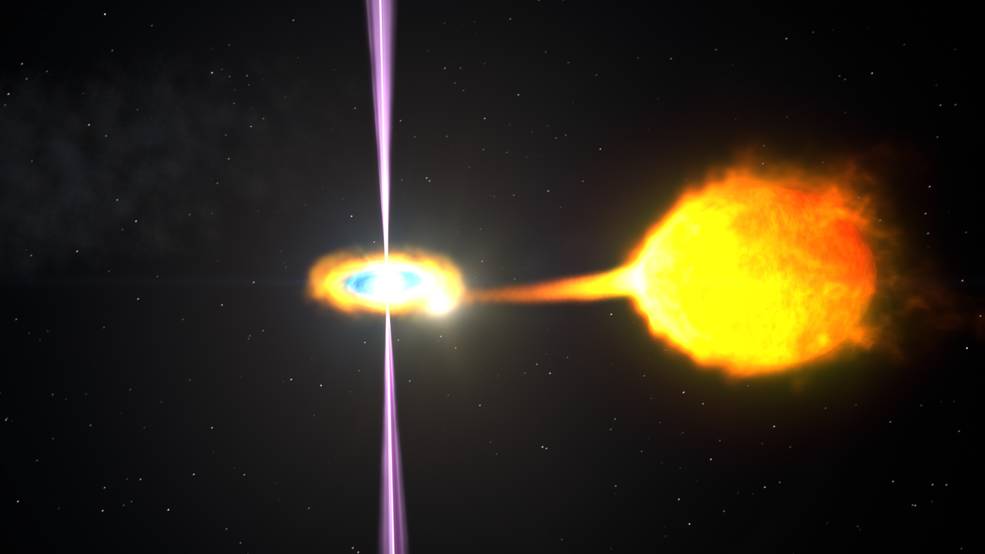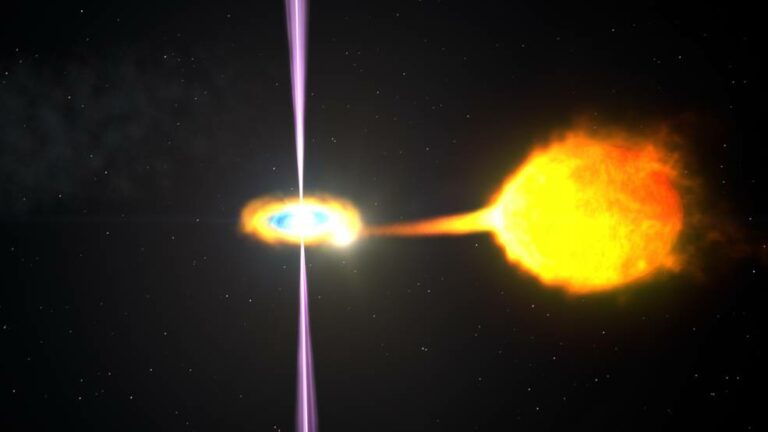Powerful Neutron Star’s Behavior Surprises IXPE Researchers
Hercules X-1, located more than 21,000 light-years from Earth, was the first accreting neutron star that NASA’s Imaging X-ray Polarimetry Explorer (IXPE) saw in February. These studies have now challenged long-held beliefs about neutron stars and the internal mechanisms that fuel these extraordinarily powerful objects.
Astrophysicist Steve Ehlert of NASA’s Marshall Space Flight Center in Huntsville, Alabama, remarked that the results were surprising. There is now a lot of puzzled and exciting head-scratching over this neutron star.
The research, which appeared in the journal Nature Astronomy’s October 24 edition, advances our understanding of these dense, whirling, undead phenomena.
In orbit, Hercules X-1 is not by alone. Its nearby companion star is stripped of its outer layers of gas by the tremendous gravity of its neighbor. Hercules X-1 is now a “accreting neutron star,” which means it is stealing streams of energy and matter from the so-called “donor” star. An accretion disk is formed around Hercules X-1 as a result of the material being pulled along the magnetic field lines of the neutron star itself.
Massive stars that have gone supernova produce neutron stars in binary systems like Hercules X-1, which was initially named 4U1656+35 in 1971. They sometimes only have a diameter of 10–12 miles (16–19 kilometers) due to the catastrophic release of energy. With a mass around 1.5–2 times that of the Sun and a magnetic field trillions of times that of Earth, they continue to be extraordinarily dense.
A pulsar is Hercules X-1 as well. As their cores collapse, neutron stars known as pulsars begin to revolve more quickly and produce intense electromagnetic radiation beams from their poles. These powerful strobes are recorded as “pulses,” which IXPE and other telescopes can see throughout thousands of light-years of space.

Credits: NASA
Ehlert pointed out that while scientists are well aware of the magnitude of a neutron star’s magnetic field, they are still mostly ignorant of its physical makeup, how and why it changes over time, and how it interacts with its donor star.
IXPE chief investigator at Marshall University Brian Ramsey declared, “That’s where IXPE truly shines.” “The effects we deduce from polarization operate on scales we could never expect to capture with traditional methods, making it difficult to directly observe them. We are able to record the behavior of the invisible world because to IXPE.
By analyzing the polarization of X-ray photons, IXPE expands on the findings of NASA’s Chandra X-ray Observatory and other space observatories. All light wavelengths are made up of interrelated electric and magnetic fields, and polarization is a feature of light that reveals this. These fields combine to produce oscillation, or vibration, perpendicular to the direction of travel of the light. We refer to a light as being polarized when its electric fields oscillate in a single, consistent direction.
IXPE is a brand-new, innovative collection of metrics that allow us to better comprehend a complicated system than ever before, according to Ramsey.
But new queries arise as we gain more insight. IXPE’s examination of Hercules X-1 produced some unexpected results, which are described in the new study. Based on scientific modeling, scientists had predicted that X-rays would be polarized to a degree of 60% to 80%, however the results revealed just 8.6% percent polarization during the course of the pulsar’s spin cycle.
IXPE study on accreting neutron stars is led by Juri Poutanen of the University of Turku in Finland. “Such a big divergence suggests that our views about how X-rays are created in Hercules X-1, and probably other pulsars, will need to be substantially updated,” he added.
Despite the two stars circle one another every 1.7 days, the system has previously displayed consistent brightness changes with a period of 35 days. Such variation may be a sign of precession, a continuous process of gradual changes to a celestial body’s orbital or rotational characteristics. Precession is referred to in astrophysics. In other words, the spinning accretion disk can be bent or wobbly.
However, it was mentioned that the pulsar itself may possibly be precessing, and IXPE measurements do in fact imply that this may be the case. stated the paper’s primary author, Victor Doroshenko of the University of Tuebingen in Germany. Additional observations will be necessary to determine what is driving the observed fluctuation and if it is related to the low polarization of X-ray emissions. To determine if the low polarization detected at Hercules X-1 is common or unique, scientists will keep observing this neutron star and others.
The opportunity to learn more about how neutron stars and black holes emit such high-energy particles, which is one of the main issues IXPE can help us solve, is what fascinates Ehlert the most, he added. Even in the harsh environs of space, that is not a simple task.
IXPE, a mission in NASA’s Small Explorer mission series, was launched in December 2021 from NASA’s Kennedy Space Center in Florida on a Falcon 9 rocket. It now circles 595 kilometers, or about 370 miles, above the equator of the planet. The project is a collaboration between the Italian Space Agency and NASA, comprising partners and scientific collaborators from 13 other nations. Spacecraft operations are overseen by Ball Aerospace, which has its headquarters in Broomfield, Colorado.
Source:NASA
Do not forget to share your opinion with us to provide you with the best posts !




0 Comments